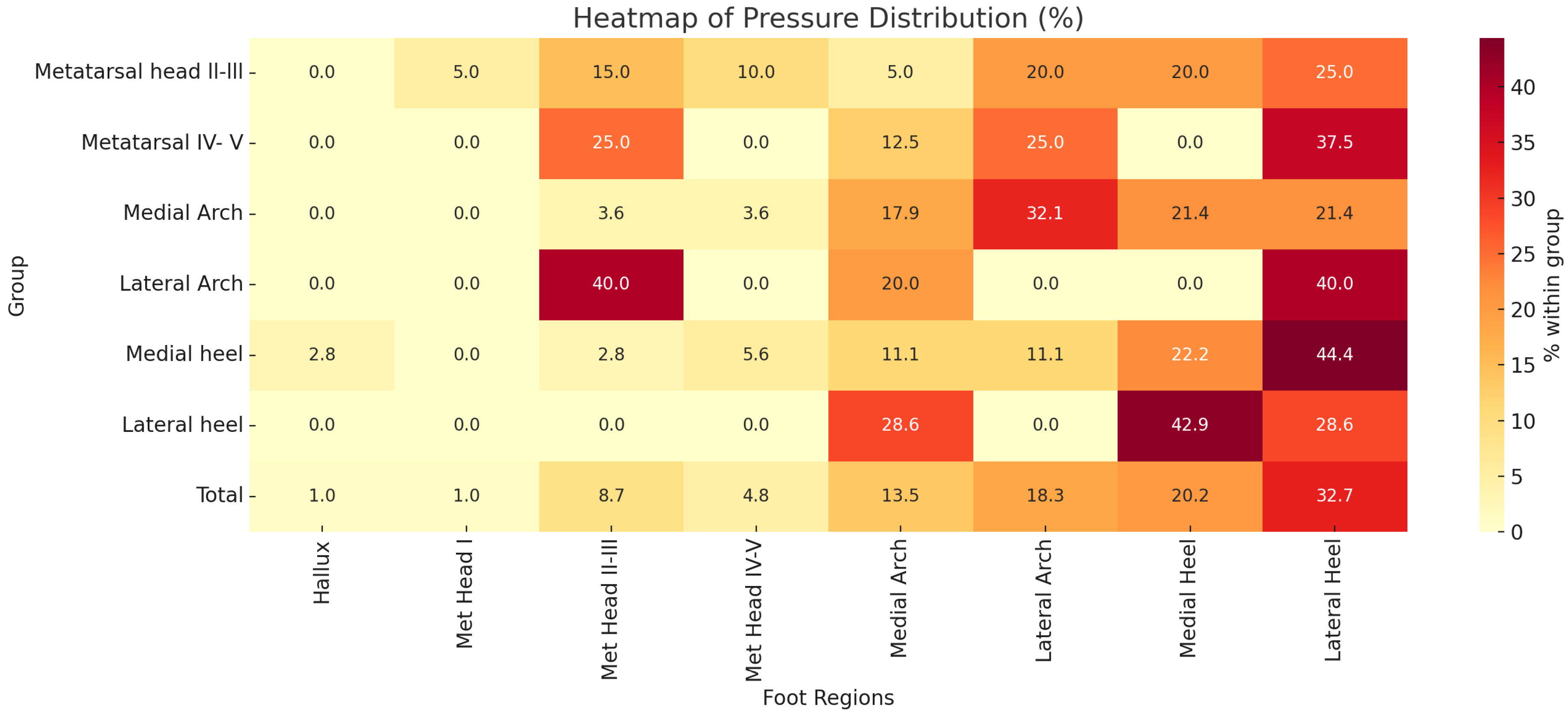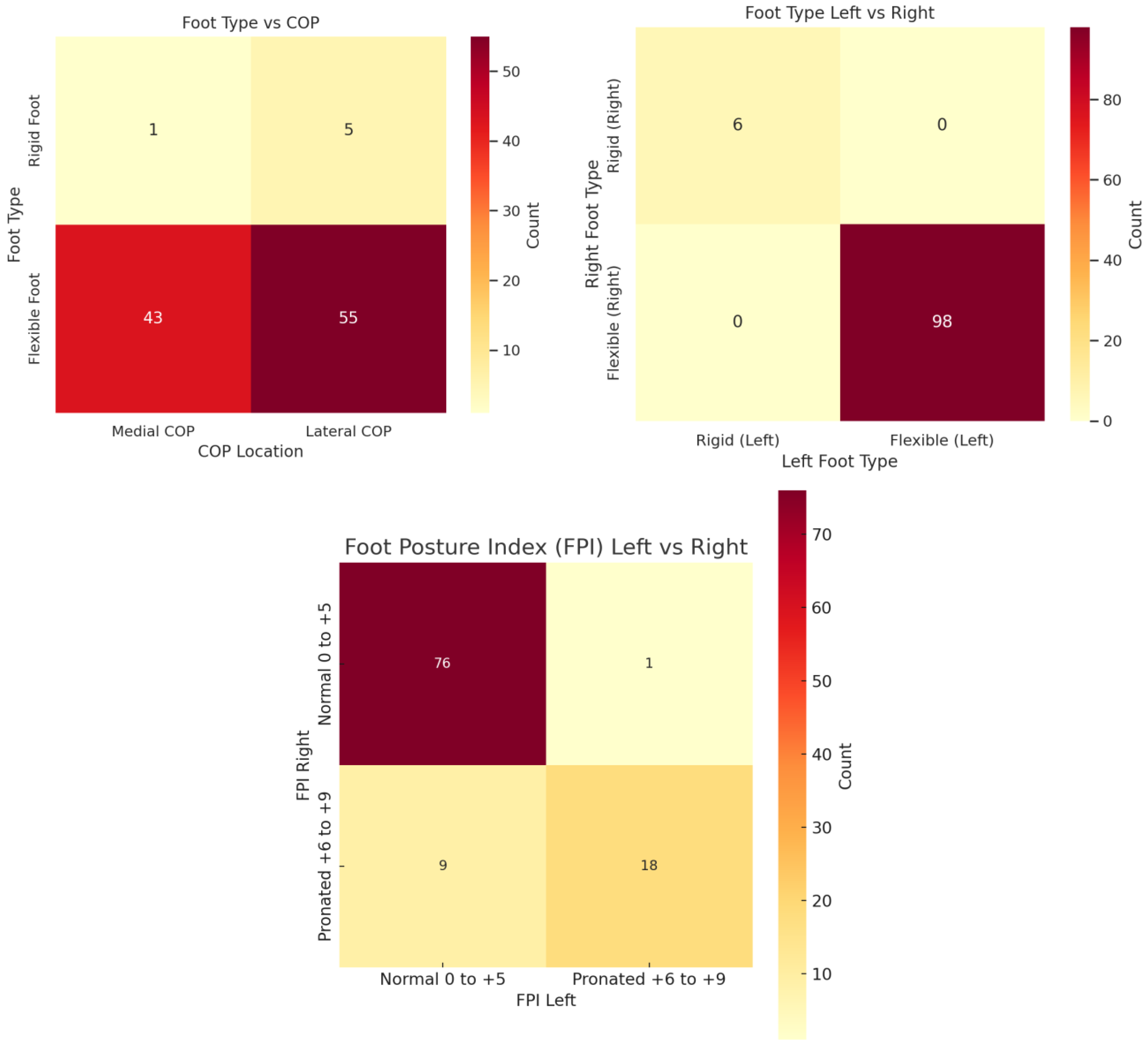Foot Posture Characteristics and Bilateral Load Distribution in African Male Recreational Runners: Insights from Foot Posture Index and 3D Scanning
Abstract
1. Introduction
2. Materials and Methods
2.1. Study Design and Population
2.2. Workflow Summary
- Population Selection.
- FPI-6 Assessment.
- 3D Foot Scans.
- Weight Measurement.
- Statistical Analysis (McNemar, Pearson chi-square, Fisher’s exact test).
2.3. Participants
2.4. Data Collection Methods
- Foot Posture Index (FPI-6):
- Talar head palpation.
- Curvature of the lateral border.
- Calcaneal position in the frontal plane.
- Prominence of the medial longitudinal arch.
- Abduction/adduction of the forefoot.
- Extent of foot contact area.
- Neutral: −5 to +5
- Pronated: +6 to +12
- Supinated: −12 to −6
- 2.
- Three-Dimensional (3D) Foot Scans:
- 3.
- Weight Measurement:
2.5. Data Analysis
2.6. Limitations of Methods
2.7. Data Recording and Reliability
3. Results
Statistical Tests
4. Discussion
4.1. Agreement or Discrepancies Between FPI-6 and 3D Foot Scans
4.2. Practical Implications
4.3. Limitations of the Study
4.4. Future Research Directions
4.5. Potential Applications of the Study
5. Conclusions
Author Contributions
Funding
Institutional Review Board Statement
Informed Consent Statement
Data Availability Statement
Acknowledgments
Conflicts of Interest
Abbreviations
| 3D | Three-dimensional |
| FPI | Foot Posture Index |
References
- Oswald, F.; Campbell, J.; Williamson, C.; Richards, J.; Kelly, P.A. Scoping Review of the Relationship between Running and Mental Health. Int. J. Environ. Res. Public Health 2020, 17, 8059. [Google Scholar] [CrossRef] [PubMed] [PubMed Central]
- Gallo, R.A.; Plakke, M.; Silvis, M.L. Common leg injuries of long-distance runners: Anatomical and biomechanical approach. Sports Health 2012, 4, 485–495. [Google Scholar] [CrossRef] [PubMed] [PubMed Central]
- Patel, S.; Bernasconi, A.; Thornton, J.; Buraimoh, O.; Cullen, N.P.; Welck, M.J.; Singh, D. Relationship between foot posture index and weight bearing computed tomography 3D biometrics to define foot alignment. Gait Posture 2020, 80, 143–147. [Google Scholar] [CrossRef]
- Hansen, P.; Brinch, S.; Radev, D.I.; Nybing, J.U.; Toftgaard, S.; Johannsen, F.E. Reliability and correlation of weight-bearing cone beam CT and Foot Posture Index (FPI) for measurements of foot posture: A test-retest study. Skelet. Radiol. 2023, 52, 2387–2397. [Google Scholar] [CrossRef]
- Terada, M.; Wittwer, A.M.; Gribble, P.A. Intra-rater and inter-rater reliability of the five image-based criteria of the foot posture index-6. Int. J. Sports Phys. Ther. 2014, 9, 187–194. [Google Scholar] [PubMed] [PubMed Central]
- Lee, Y.C.; Lin, G.; Wang, M.J.J. Comparing 3D foot scanning with conventional measurement methods. J. Foot Ankle Res. 2014, 7, 44. [Google Scholar] [CrossRef] [PubMed]
- Wang, X.; Cheng, Z. Cross-Sectional Studies: Strengths, Weaknesses, and Recommendations. Chest 2020, 158, S65–S71. [Google Scholar] [CrossRef] [PubMed]
- Menz, H.B. Biomechanics of the Ageing Foot and Ankle: A Mini-Review. Gerontology 2015, 61, 381–388. [Google Scholar] [CrossRef] [PubMed]
- Statistics South Africa. Mid-Year Population Estimates 2024; Statistics South Africa: Pretoria, South Africa, 2024. [Google Scholar]
- Chen, B.; Liu, P.; Xiao, F.; Liu, Z.; Wang, Y. Review of the Upright Balance Assessment Based on the Force Plate. Int. J. Environ. Res. Public Health 2021, 18, 2696. [Google Scholar] [CrossRef] [PubMed] [PubMed Central]
- 118th Annual Meeting of the American Association of Colleges of Pharmacy, Nashville, Tennessee, July 15–19, 2017. Am. J. Pharm. Educ. 2017, 81, S5. [CrossRef] [PubMed Central]
- Kim, H.Y. Statistical notes for clinical researchers: Chi-squared test and Fisher’s exact test. Restor. Dent. Endod. 2017, 42, 152–155. [Google Scholar] [CrossRef] [PubMed] [PubMed Central]
- Morrison, S.C.; Ferrari, J. Inter-rater reliability of the Foot Posture Index (FPI-6) in the assessment of the paediatric foot. J. Foot Ankle Res. 2009, 2, 26. [Google Scholar] [CrossRef] [PubMed] [PubMed Central]
- Telfer, S.; Woodburn, J. The use of 3D surface scanning for the measurement and assessment of the human foot. J. Foot Ankle Res. 2010, 3, 19. [Google Scholar] [CrossRef] [PubMed] [PubMed Central]
- Carpes, F.P.; Mota, C.B.; Faria, I.E. On the bilateral asymmetry during running and cycling—A review considering leg preference. Phys. Ther. Sport 2010, 11, 136–142. [Google Scholar] [CrossRef] [PubMed]
- Polk, J.D.; Stumpf, R.M.; Rosengren, K.S. Limb dominance, foot orientation and functional asymmetry during walking gait. Gait Posture 2017, 52, 140–146. [Google Scholar] [CrossRef] [PubMed]
- Pappas, E.; Shiyko, M.P.; Ford, K.R.; Myer, G.D.; Hewett, T.E. Biomechanical Deficit Profiles Associated with ACL Injury Risk in Female Athletes. Med. Sci. Sports Exerc. 2016, 48, 107–113. [Google Scholar] [CrossRef] [PubMed] [PubMed Central]
- Fagerland, M.W.; Lydersen, S.; Laake, P. The McNemar test for binary matched-pairs data: Mid-p and asymptotic are better than exact conditional. BMC Med. Res. Methodol. 2013, 13, 91. [Google Scholar] [CrossRef] [PubMed]
- DeBerardinis, J.; Neilsen, C.; Lidstone, D.E.; Dufek, J.S.; Trabia, M.B. A comparison of two techniques for center of pressure measurements. J. Rehabil. Assist. Technol. Eng. 2020, 7, 2055668320921063. [Google Scholar] [CrossRef] [PubMed] [PubMed Central]
- Mei, Q.; Kim, H.K.; Xiang, L.; Shim, V.; Wang, A.; Baker, J.S.; Gu, Y.; Fernandez, J. Toward improved understanding of foot shape, foot posture, and foot biomechanics during running: A narrative review. Front. Physiol. 2022, 13, 1062598. [Google Scholar] [CrossRef] [PubMed] [PubMed Central]
- Yousefi, M.; Zivari, S.; Yiou, E.; Caderby, T. Effect of Chronic Ankle Instability on the Biomechanical Organization of Gait Initiation: A Systematic Review. Brain Sci. 2023, 13, 1596. [Google Scholar] [CrossRef] [PubMed] [PubMed Central]
- Liu, W.; Xu, L.; Wu, H.; Wang, Y.; Jiang, H.; Gao, Z.; Jánosi, E.; Fekete, G.; Mei, Q.; Gu, Y. Bilateral Asymmetries of Plantar Pressure and Foot Balance During Walking, Running, and Turning Gait in Typically Developing Children. Bioengineering 2025, 12, 151. [Google Scholar] [CrossRef] [PubMed] [PubMed Central]
- Lopes, T.J.A.; Simic, M.; Myer, G.D.; Ford, K.R.; Hewett, T.E.; Pappas, E. The Effects of Injury Prevention Programs on the Biomechanics of Landing Tasks: A Systematic Review With Meta-analysis. Am. J. Sports Med. 2018, 46, 1492–1499. [Google Scholar] [CrossRef] [PubMed] [PubMed Central]
- Menz, H.B.; Bonanno, D.R. Footwear comfort: A systematic search and narrative synthesis of the literature. J. Foot Ankle Res. 2021, 14, 63. [Google Scholar] [CrossRef] [PubMed] [PubMed Central]
- Menz, H.B. Foot Problems in Older People: Assessment and Management; Churchill Livingstone: London, UK, 2008. [Google Scholar]




Disclaimer/Publisher’s Note: The statements, opinions and data contained in all publications are solely those of the individual author(s) and contributor(s) and not of MDPI and/or the editor(s). MDPI and/or the editor(s) disclaim responsibility for any injury to people or property resulting from any ideas, methods, instructions or products referred to in the content. |
© 2025 by the authors. Licensee MDPI, Basel, Switzerland. This article is an open access article distributed under the terms and conditions of the Creative Commons Attribution (CC BY) license (https://creativecommons.org/licenses/by/4.0/).
Share and Cite
Choonara, Y.M.; Paton, G.J. Foot Posture Characteristics and Bilateral Load Distribution in African Male Recreational Runners: Insights from Foot Posture Index and 3D Scanning. J. Funct. Morphol. Kinesiol. 2025, 10, 361. https://doi.org/10.3390/jfmk10030361
Choonara YM, Paton GJ. Foot Posture Characteristics and Bilateral Load Distribution in African Male Recreational Runners: Insights from Foot Posture Index and 3D Scanning. Journal of Functional Morphology and Kinesiology. 2025; 10(3):361. https://doi.org/10.3390/jfmk10030361
Chicago/Turabian StyleChoonara, Yaasirah Mohomed, and Glen James Paton. 2025. "Foot Posture Characteristics and Bilateral Load Distribution in African Male Recreational Runners: Insights from Foot Posture Index and 3D Scanning" Journal of Functional Morphology and Kinesiology 10, no. 3: 361. https://doi.org/10.3390/jfmk10030361
APA StyleChoonara, Y. M., & Paton, G. J. (2025). Foot Posture Characteristics and Bilateral Load Distribution in African Male Recreational Runners: Insights from Foot Posture Index and 3D Scanning. Journal of Functional Morphology and Kinesiology, 10(3), 361. https://doi.org/10.3390/jfmk10030361





